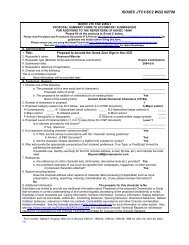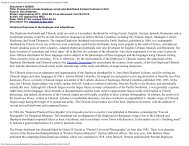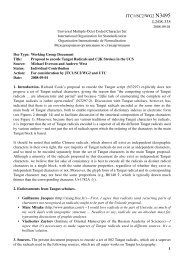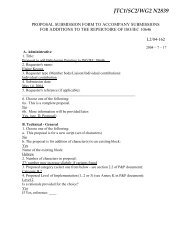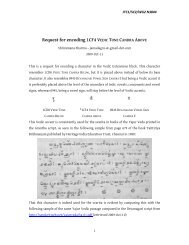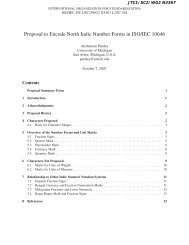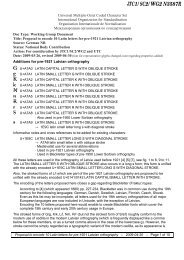ISO/IEC JTC1/SC2/WG2 N 4161R - DKUUG standardizing
ISO/IEC JTC1/SC2/WG2 N 4161R - DKUUG standardizing
ISO/IEC JTC1/SC2/WG2 N 4161R - DKUUG standardizing
Create successful ePaper yourself
Turn your PDF publications into a flip-book with our unique Google optimized e-Paper software.
Regarding the interrobangs, the original Wingdings proposal <strong>WG2</strong> N4115 also shows a "serifed-font-style"<br />
interrobang (ID 2093) which is considered to be unified with U+203D INTERROBANG.<br />
This is glyph encoding. Even if it is agreed that Wingding characters are to be included into Unicode without proof<br />
of actual use (but only based on availability on a large part of present-day computing equipment), there is no<br />
argument that roundtrip encoding between Unicode (<strong>ISO</strong>/<strong>IEC</strong> 10646) and the "existing standard" Wingdings is<br />
necessary (which would be the only reason to accept glyph encoding). Also, unifying just one glyph (the<br />
"serifedfont- style" one) with the existing character is arbitrary.<br />
In fact, all these characters already are perfectly represented in Unicode (by U+0026 AMPERSAND and U+203D<br />
INTERROBANG), and U+1F671 is perfectly represented in Unicode when U+1F670 is accepted. The exact glyph<br />
is to be selected by the rendering system (font etc.), according to the Unicode character/glyph model (as it has to be<br />
done even with the PDAM 1.2 character set, as a "serifed-font-style" interrobang glyph can only be gained by<br />
selecting an appropriate font)..<br />
Proposed change by Germany:<br />
Germany requests the removal of the listed characters except U+1F670.<br />
To offer a compromise, Germany considers this comment accepted also if the following is done, based on the fact<br />
that the specific appearance of the "sans-serif ampersand" may constitute a character identity rather than a glyph<br />
variation, and based on the fact that there already are "heavy" variants of punctuation marks in the Dingbats block:<br />
Only U+1F678 and U+1F679 are removed. The other characters are renamed as follows:<br />
U+1F670 SCRIPT LIGATURE ET<br />
U+1F671 HEAVY SCRIPT LIGATURE ET SYMBOL<br />
U+1F672 LIGATURE OPEN ET (or similar)<br />
U+1F673 HEAVY LIGATURE OPEN ET (or similar) SYMBOL<br />
U+1F674 HEAVY AMPERSAND SYMBOL<br />
U+1F67A HEAVY INTERROBANG SYMBOL<br />
following by any rearrangement of the code points (including, but not requested here, moving of<br />
1F670/1F672/1F675 to the Supplemental Punctuation block in the BMP).<br />
Propose acceptance in principle<br />
See also comments T1and T10 from Ireland.<br />
Accepting the compromise of renaming the controversial characters resolves the issue for all but the ‘interrobang’<br />
characters. The problems remain for the serif versus sans-serif distinctions which is specific to the Wingdings set<br />
and did not exist in Dingbats. The argument for preserving these 4 variants was to maintain a source separation<br />
rule for Wingdings which would be destroyed if those 4 interrobang characters are not encoded separately. The<br />
compromise proposed by Germany preserves dis-unification for one serif character (Wingdings2-093), one<br />
sans-serif character (wingdings2-096) but unifies the other two. It would have been cleaner to dis-unify either the<br />
two sans-serifs or the two serifs, but not a mix. It should also be noted that none of the Wingdings symbols shown<br />
here enlarged are good representation of the interrobang symbol:<br />
Page 5<br />
Glyph ID Wingdings 2-093 Wingdings 2-094 Wingdings 2-095 Wingdings 2-096<br />
Proposed<br />
UCS<br />
Glyph<br />
203D 1F678 1F679 1F67A<br />
� � � �



